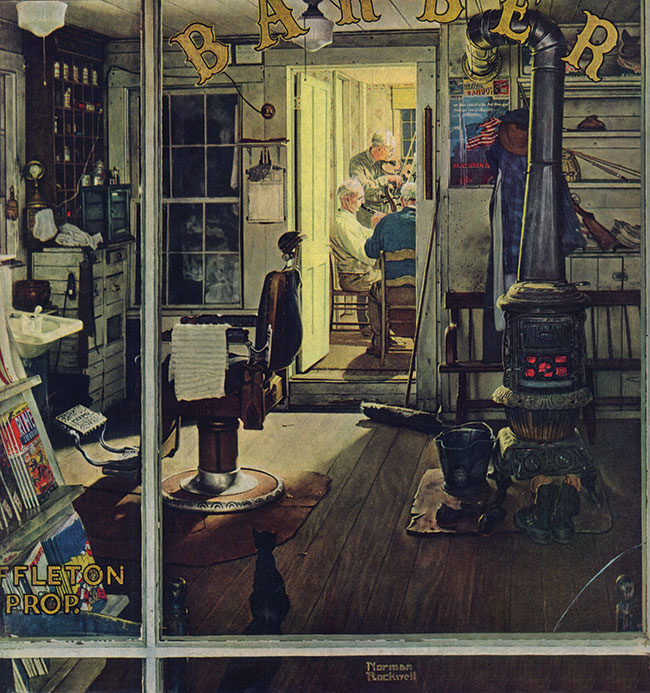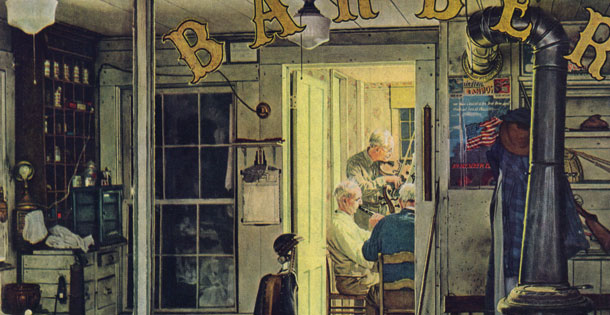
On the day last summer that he shuttered his one-chair barbershop in Northport, New York — after a half century of dedicated snipping — Richard Pastore was still charging his customers $3.50 for a cut. Remarkably, he hadn’t increased his prices since John F. Kennedy was president.
Attending to his neighbors’ hair was about the sheer pleasure of it, and not merely about earning an income, Pastore told the local paper before his shop closed.
Good luck finding a Richard Pastore in your patch of America. The era of the buddy barber is fading. It is being replaced by soulless franchises, rock ’n’ roll-themed mega shops, and ritzy men’s salons. Shuffleton’s Barbershop — the now-famous Norman Rockwell illustration that graced the cover of The Saturday Evening Post on April 29, 1950 — depicts a barbershop that exists these days almost entirely in our astringent-addled memories.
And yet in the taxonomy of classic American icons, the corner barbershop remains pretty near the top, along with hot dogs and Corvette convertibles.
Fact is, those beckoning striped poles are no longer as much a repetitive feature across our national landscape. The encouraging news, however, is that many indie barbershops are hanging on, if by a hair.
If you were to consider opening a small barbershop today, and you had the dough for rent and tools (about $1,000 for a starter set), it would be a gamble, sure, but not the worst idea in the world. Barbers cannot be replaced; there are no apps for that — yet.
The first thing you’d need to get is a pole. Depending on the model, that would set you back anywhere from $483 to $1,218, assuming you purchased from the William Marvy Company, which is the only outfit in America that still manufactures the signage. Bob Marvy is its owner.
He has never forgiven the hippies for disrupting what had been, until the ’60s, a thriving profession. “The Vietnam war really affected the mood of the country. In came long hair — and the barbering industry took a wrong turn,” Marvy says. According to the U.S. Census, the number of barbershops declined by roughly 25 percent during the war years.
What must barbers do to survive in this new world order? My own guy, a dapper fellow named James Synnott, who has been cutting for 50 years, says, “To do this right, you’ve got to have a doctor’s degree in BS. It’s all about the camaraderie.”
Another way to massage business is to exploit social media. Junior Vitiello, a young entrepreneur who owns a shop in upscale Jupiter, Florida, tells people, “If you post nice comments about our place on Facebook, I’ll give you $4 off your next cut.”
For now, it appears two phenomena are largely responsible for keeping America’s barbershops buzzing. First is African-Americans’ fierce attachment to barbershop culture. Second is America’s penchant for war. Charles Kirkpatrick, executive director of Barbers International, a professional association, says images of neatly shorn troops heading off to battle invariably inspire copycat styles. War “is absolutely good for the barber business,” Kirkpatrick believes.
There is thus an ironic strand that runs through barber history: War, which once nearly killed the shops, has lately helped to save them.
Become a Saturday Evening Post member and enjoy unlimited access. Subscribe now




Comments
My barber to my question said,
When I asked for a good cut new,
“Becuz it’s on the same old head,”
“No miracle that I can do.”
No shortcuts would my barber take.
“I’m in a hurry,” I would say.
Guess my barber wanted to make
The hair I had left, turn to gray.
My barber asked if I did wear
Anything red around my neck.
I said no, that my neck was bare.
My barber cut on, “What the heck!”
My barber says one word in groups.
It is a four letter word, “Oops!”